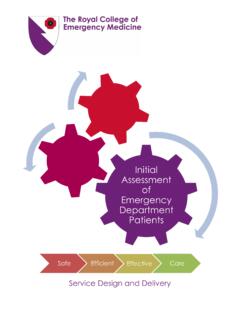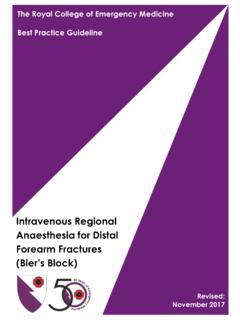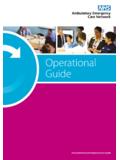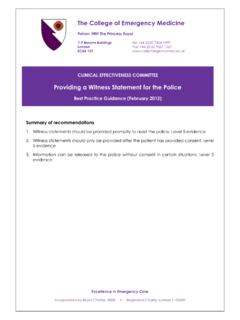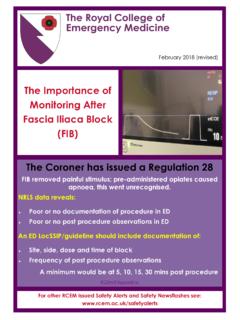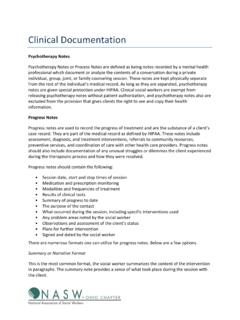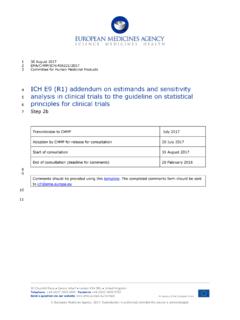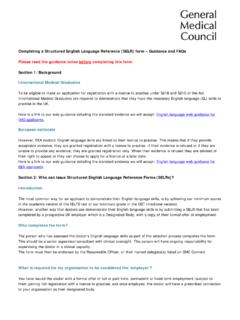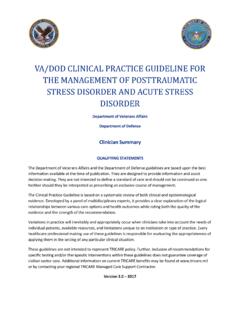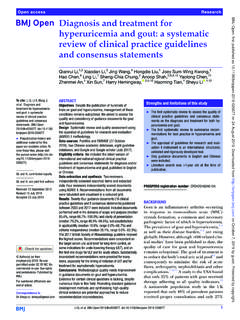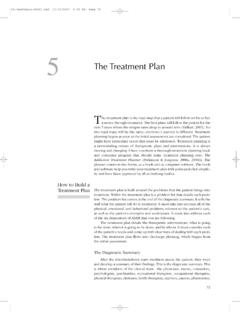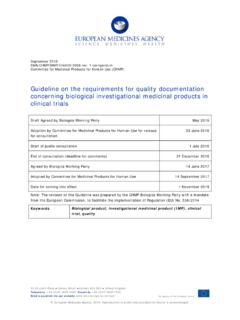Transcription of THE COLLEGE OF EMERGENCY MEDICINE - rcem.ac.uk
1 clinical Standards for EMERGENCY Departments (Aug 2014) 1 The COLLEGE of EMERGENCY MEDICINE clinical Standards for EMERGENCY Departments August 2014 clinical Standards for EMERGENCY Departments (Aug 2014) 2 Version Control Originally published Aug 2012 Update published February 2013. Mental Health standards added. Update published September 2013. Paracetamol overdose standards revised. This version published August 2014. Fitting Child and Cognitive Impairment in Older People added. Contact Please send your feedback to clinical Standards for EMERGENCY Departments (Aug 2014) 3 Introduction The clinical Standards for EMERGENCY Departments (EDs) have been produced by the clinical Effectiveness Committee of the COLLEGE of EMERGENCY MEDICINE . They are evidence based where possible or developed by consensus from EMERGENCY Physicians with relevant expertise and with input from other stakeholders.
2 The standards are reviewed annually to include any new evidence or following a review of the results of the audit programme. Dr Jay Banerjee Chair, Standards & Audit subcommittee, CEM Contents Asthma p4 Cognitive Impairment in Older People p5 Dislocated Shoulder p7 Feverish Children p7 Fitting Child p8 Fractured Neck of Femur p9 Head Injury in Adults (under review) p9 Hand injury p10 Mental Health p10 Pain p11 Paracetamol Overdose p11 Radiology (under review with Royal COLLEGE of Radiologists) p12 Recording of Adult Vital Signs in the Major and Resuscitation Areas of the ED p12 Renal Colic p13 Retention of Urine p13 Safeguarding Children p14 Sepsis & Meningitis in Children p15 Severe Sepsis and Septic Shock in Adults p16 Spontaneous Pneumothorax in Adults p17 Please note that certain standards are currently unchanged from the previous versions as they are still under review clinical Standards for EMERGENCY Departments (Aug 2014) 4 Asthma Standards 1.
3 O2 prescribed on arrival to maintain O2 saturation > 92% 2. Senior EM / ICU / PICU help summoned within 30min of arrival if any life threatening features present 3. Vital signs taken as per CEM standard (page 9) 4. Salbutamol or terbutaline and ipratropium given as per dosages below within 5 minutes (if Life Threatening) or 10 minutes (if Moderate or Severe) of arrival and repeated within 15 minutes of the first measurement: Drug Adults Children Salbutamol 5mg or terbutaline + ipratropium 5-10 mg + (by nebuliser) 5mg + (by spacer or nebuliser) or salbutamol IV 250 microgram (5mcg/kg) N/A 5. CXR performed (if Life Threatening) 6. IV hydrocortisone or oral prednisone given as per dosages below within 60 minutes of arrival (if Life Threatening) or before leaving the ED (if Moderate or Severe) Drug Adults Children IV hydrocortisone 100mg 100mg (50 mg if 2 5 years) or oral prednisone 40-50mg 30-40mg (20mg if 2 5 years) 7.
4 Patients transferred to ITU / PICU they should be accompanied by a doctor (with suitable resuscitation & airway equipment) who is able to intubate the patient if necessary. 8. 90% of discharged patients to be prescribed oral prednisolone as follows: Drug Adults Children Oral prednisolone 30 50mg for 5 days 30 40 mg (> 5 years) for 3 days 20mg (2 5 years) for 3 days 9. Appropriate advice is given for follow up. References 1. BTS/SIGN Asthma Guideline clinical Standards for EMERGENCY Departments (Aug 2014) 5 Cognitive Impairment in Older People Standards There must be documented evidence in the patient s clinical record that: 1. All patients over the age of 75 are assessed for cognitive impairment (CI) in the EMERGENCY Department (ED). 2. Assessments for CI are done using a structured tool and the tool used is documented. 3. The findings of CI assessment are provided to the relevant admitting services for admitted patients.
5 4. The findings of CI assessment are provided to the patient s GP if of new onset or in the event of any deterioration. 5. Information regarding CI is provided to the patient s carers at the time of admission to hospital or discharge back to their usual place of residence unless this information was available from these sources. 6. All patients over the age of 75 have at least one Early Warning Score assessment. Definitions Standard 1: Assessment in this context, refers to the act of objectively quantifying the cognitive state of the person. Reason for the measure: This measure will identify patients with delirium, delirium superimposed on dementia and dementia presenting to ED. Pre-existing dementia makes older people more prone to developing delirium so they must be included in the assessment process. Standard 2: A structured tool to assess CI includes: 4AT (The 4 A s Test) 6-CIT (6 item Cognitive Impairment Test) AMT-4 (Abbreviated Mental Test 4 items) AMT-10 (Abbreviated Mental Test 10 items) CAM (Confusion Assessment Method) MMSE (Mini Mental State Examination) MoCA (Montreal Cognitive Assessment) If using any other tool, please provide a reference.
6 Documents means the name of the tool used and the patient s score on the tool are recorded in the patient record. "Record" includes paper and electronic versions Standard 3: Findings of CI assessment: a minimum subjective description of whether it is normal or abnormal; ideally the documentation would include a score using a structured tool. clinical Standards for EMERGENCY Departments (Aug 2014) 6 Handover information includes at least one documentation of cognitive state as normal or abnormal with or without an objective score; information in the patient's ED records are made available to the admitting service either as a paper record (photocopy or original) or electronically or a documented evidence that a verbal handover included sharing the cognitive state. Please describe any other reasonable local handover method used. Standard 4: Findings of CI assessment are provided to the patient s GP includes at least the name of the tool used and the patient s score.
7 It is not expected that information about previously diagnosed dementia would be shared with the GP. However any changes would be expected to be conveyed to the GP, especially presentation with delirium (sudden deterioration in cognitive state corroborated by carers and/or families). Standard 5: The patient record states any of the following or similar terms to clearly convey the message that the information on CI was shared with carers: "confusion", "delirium" "dementia" AND "discussed with" or "communicated to" carers. If this information was volunteered by the carer, the patient's record will not be included for this standard. Standard 6: Any tool including MEWS or NEWS will be acceptable. The total early warning score has to be documented. References 1. 'The Silver Book': Quality Care for Older People with Urgent and EMERGENCY Care Needs (Multiple, June 2012). 2. NICE guideline: delirium CG103 (July 2010) 3.
8 NICE Quality Standard: Delirium QS63 (July 2014) 4. Cei M, Bartolomei C, Mumoli N. In-hospital mortality and morbidity of elderly medical patients can be predicted at admission by the Modified Early Warning Score: a prospective study. Int J Clin Pract, April 2009, 63, 4, 591 595 doi: 5. Counting the cost: Caring for people with dementia on hospital wards. Alzheimer's Society, 2009. 6. Ferguson C, Woodard J, Banerjee J, Conroy S. Operationalising frailty definitions in the EMERGENCY department - a mapping exercise. Age Ageing 2010; 39(S1):i7. (Accessed May 29, 2014) 7. Dalziel B. Dementia subtypes and their prevalence: latest thoughts. Geriatr Aging. 2007;10:12. 8. Fong T, Tulebaev SR & Inouye SK. Delirium in elderly adults: diagnosis, prevention and treatment. Nat Rev Neurol. Apr 2009; 5(4): 210 220. 9. Hustey FM, Meldon SW, Smith MD, et al. The effect of mental status screening on the care of elderly EMERGENCY department patients.
9 Annals Emerg Med. 2003 May; 41(5):678 84. 10. Suffelletto B, Miller T, Frisch A, Callaway C. EMERGENCY physician recognition of delirium (2013). Postgrad Med J clinical Standards for EMERGENCY Departments (Aug 2014) 7 11. Wanless, D. Securing good care for older people (2006). The Kings Fund. (Accessed May 29, 2014) Dislocated Shoulder Standards 1. Pain managed as per CEM standard (page 8) 2. X-ray within 60 minutes of arrival 75% 3. 75% - 1st attempt at reduction within 2 hours and 90% within 3 hours of arrival 4. The name, dose and time of administration of sedation drug documented 5. Post-reduction X-Ray and result of review documented in the notes 6. Follow up arrangements documented (or the reasons why no follow-up necessary) References These standards are consensus based Feverish Children Introduction These standards are derived from the NICE guideline Feverish illness in children: Assessment and initial management in children younger than 5 years 1, which provides a tool to risk assess feverish children for serious bacterial illness The Traffic Light System2 is recommended for use in EDs An adequate safety net is defined as a) providing the parent or carer with verbal and/or written advice on warning symptoms and how further care can be accessed or b) the parent or carer is given follow up at a specific time and place or c) ensuring direct access for the patient if further assessment is required.
10 Standards 1. Children presenting to EMERGENCY Departments (EDs) with medical conditions should have respiratory rate, oxygen saturation, pulse, blood pressure/capillary refill, GCS/AVPU and temperature measured and recorded as part of the routine assessment 2. Discharged children in whom no diagnosis is found and with amber features, as defined in the NICE guideline, should be provided with an appropriate safety net 3. 90% of children with amber features and without an apparent source of infection should not be prescribed antibiotics 4. Children with fever and without an apparent source of infection but with one or more red features should have FBC, CRP, blood culture and urinalysis performed 5. EDs should have written advice to give to the carer/s of discharged children 6. EDs should have access to the NICE guideline Traffic Light System. References 1. Feverish illness in children - Assessment and initial management in children younger than 5 years, National Collaborating Centre for Women s and Children s Health clinical Standards for EMERGENCY Departments (Aug 2014) 8 (Commissioned by the National Institute for Health and clinical Excellence), NICE CG47, May 2007 2.
